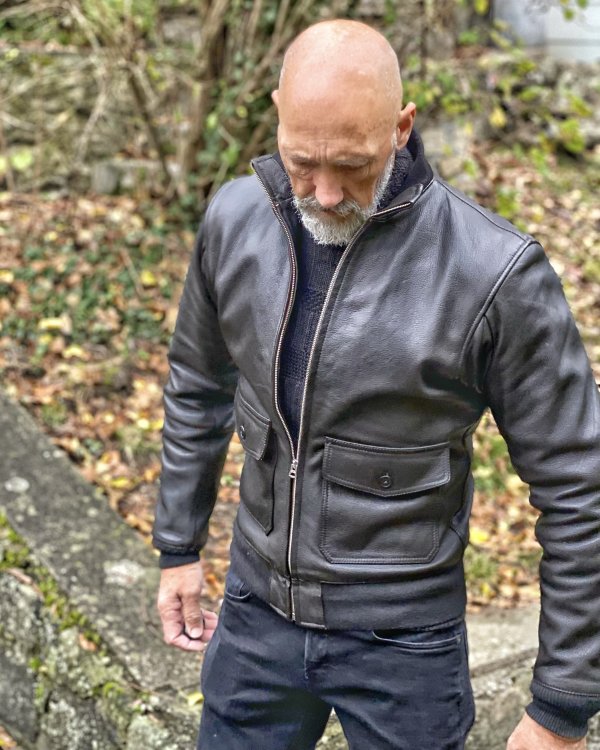I would think again about the darts. There are too many well-fitting leather jackets without these things. Side panels, centre seam, gussets will do just fine.Shorter darts means a wider angle, and a wider angle causes them to pucker/get pointy. Reducing the angle reduces the curve on the edge and flattens everything out. It's possible to reduce the puckering by forming over a curved... form, but not sure if/how that works with leather, and that may not be an option.
This is about as fitted as possible. If I can move all around with a piece of thick paper scotch taped to me, and it stays put and doesn't even come off (again, scotch tape on a t-shirt; hardly a strong bond), that's really saying something. I had full range of motion with my arms and torso; leaning side to side, touching my toes, arms swinging all the way around. Wife commented at some point that it seems likely the fashion is for a much flatter, looser fit. I will undoubtedly need to loosen it up for ease, but haven't gotten to that point yet.
The understanding of how the darts work, where they need to be and at what magnitude to achieve what effect was the point of the exercise. Now I can play around with them a bit more to loosen things up for an actual jacket rather than a fitted shell.
A bit late, but wife just found this:
[/URL]
We started with the darts I had in my design, drawn purely by feel and for aesthetics. We then iteratively manipulated them until we ended up where we did, which, coincidentally, is just about exactly what's shown in that link. Wife may have had some clue about that from her sewing exploits, but I had no idea about that general size/angle/location. We clearly just reversed engineered something that is apparently generally well known... Oh well. The point was to learn, and that's what we did. If I had had the vocabulary to find that, maybe we could have saved some trees.
Want to buy or sell something? Check the classifieds
-
The Fedora Lounge is supported in part by commission earning affiliate links sitewide. Please support us by using them. You may learn more here.
You are using an out of date browser. It may not display this or other websites correctly.
You should upgrade or use an alternative browser.
You should upgrade or use an alternative browser.
Five Star Leather Jackets
- Thread starter TooManyHatsOnlyOneHead
- Start date
I would think again about the darts. There are too many well-fitting leather jackets without these things. Side panels, centre seam, gussets will do just fine.
And to speak to his objective, it is throwing in one more variable for Five Star, one that I don't think they have much experience with.
- Messages
- 17,683
And to speak to his objective, it is throwing in one more variable for Five Star, one that I don't think they have much experience with.
spectre6000
One of the Regulars
- Messages
- 192
It is a textile jacket, but it's the style that's pertinent. The point is front darts in a manner that doesn't look feminine (to my eye at least). Darts are standard in women's clothing to make the bust work. Lots of curvature to accommodate for there. Men don't have as much curvature to deal with, but also not zero.This looks like a textile jacket, not a leather jacket, though it looks terrible even in this instance.
If you were trying to find an example of a textile jacket for men with darts you could have posted any suit coat that's not an American Ivy League cut or Anderson & Sheppard drape cut. Darts are used in the front to generate shape in the mid section.
Additionally, I really don't want a breast pocket. I don't smoke, they're always too small to really be useful, and honestly they're really just decoration most of the time. That empty space above the pockets without it just seems too empty. Darts accomplish adding a small amount of visual interest AND give the panel shape. Twofer. Any time a visual detail also serves a practical purpose, it has my attention.
The way these well fitting jackets work without the darts is by a) working the same removal of material into the gaps between the panels, which Fivestar doesn't seem to do, or b) by forming the leather over (whatever the leather equivalent of a buck or a ham is called), which they also don't seem to do.I would think again about the darts. There are too many well-fitting leather jackets without these things. Side panels, centre seam, gussets will do just fine.
One of the complaints I've seen with their jackets is that they're flat. They are. Both sleeves and torsos. You can see it in every product listing on their page. Even when they have darts, it looks like they're taking in the minimum amount of material required to get the line stitched in for design purposes. I suspect what they're doing is taking a flat bodice pattern from one of their commercial white label designs, drawing the details onto it, and then cutting them out, adding seam allowances, and sewing them back together into a flat panel.
Yes and no. It's a cutting and sewing step they must take, which are things they really don't have any issues with, and the variable is being shifted to my control. Darts are pretty simple geometrically not only to execute, but to communicate, and they result in much more complex geometry. The hard part is figuring out where, what angle, and how much to achieve the desired curvature. I've done the bulk of that work (I still need to reduce it all for ease), so that major and difficult variable has been eliminated.And to speak to his objective, it is throwing in one more variable for Five Star, one that I don't think they have much experience with.
For example, "X inches from the centerline, at an angle of Y°, and Z inches wide". That's a complete dart communicated with hard numbers in a way that's very difficult to interpret incorrectly. Additionally, by making the paper pseudo pattern, I can also grid it off in inches to accurately communicate details that aren't structural. Finally, making these full size paper pseudo templates allows me to visualize things and not have to guess on the measurements of any particular thing.
AHP91
One Too Many
- Messages
- 1,179
Re: darts only being for women in the front:
View attachment 592287
It's not entirely without precedent. I feel like I've seen similar darts elsewhere as well, but clearly a small minority.
What makes you think that isn’t a women’s jacket? I reverse imaged it and it’s a 1930s Levi’s with the following measurements:
Chest (pit to pit): 19″ (doubled = 38″)
Shoulder to shoulder: 15″
Sleeve (shoulder to cuff): 21-1/2″
Length (Base of collar to hem): 20″
These are incredibly small men’s measurements even for 1930s standards
spectre6000
One of the Regulars
- Messages
- 192
The dart in that location is arching the top panel toward the shoulders. Every human has that curve. The dart isn't in any way doing anything female specific, and everything else looks like a pretty standard mens jacket.
I'm not sure if you're getting caught up in something.It is a textile jacket, but it's the style that's pertinent. The point is front darts in a manner that doesn't look feminine (to my eye at least). Darts are standard in women's clothing to make the bust work. Lots of curvature to accommodate for there. Men don't have as much curvature to deal with, but also not zero.
Additionally, I really don't want a breast pocket. I don't smoke, they're always too small to really be useful, and honestly they're really just decoration most of the time. That empty space above the pockets without it just seems too empty. Darts accomplish adding a small amount of visual interest AND give the panel shape. Twofer. Any time a visual detail also serves a practical purpose, it has my attention.
The way these well fitting jackets work without the darts is by a) working the same removal of material into the gaps between the panels, which Fivestar doesn't seem to do, or b) by forming the leather over (whatever the leather equivalent of a buck or a ham is called), which they also don't seem to do.
One of the complaints I've seen with their jackets is that they're flat. They are. Both sleeves and torsos. You can see it in every product listing on their page. Even when they have darts, it looks like they're taking in the minimum amount of material required to get the line stitched in for design purposes. I suspect what they're doing is taking a flat bodice pattern from one of their commercial white label designs, drawing the details onto it, and then cutting them out, adding seam allowances, and sewing them back together into a flat panel.
Yes and no. It's a cutting and sewing step they must take, which are things they really don't have any issues with, and the variable is being shifted to my control. Darts are pretty simple geometrically not only to execute, but to communicate, and they result in much more complex geometry. The hard part is figuring out where, what angle, and how much to achieve the desired curvature. I've done the bulk of that work (I still need to reduce it all for ease), so that major and difficult variable has been eliminated.
For example, "X inches from the centerline, at an angle of Y°, and Z inches wide". That's a complete dart communicated with hard numbers in a way that's very difficult to interpret incorrectly. Additionally, by making the paper pseudo pattern, I can also grid it off in inches to accurately communicate details that aren't structural. Finally, making these full size paper pseudo templates allows me to visualize things and not have to guess on the measurements of any particular thing.
But try it out and you'll see and you'll definitely have learnt something.
My complaint towards 5* was rarely the body of the jackets, but rather sleeves and various details and of course the leather, which was my main point.
These jackets of mine were not bad and I would have kept them if I had liked the leather.
Attachments
-
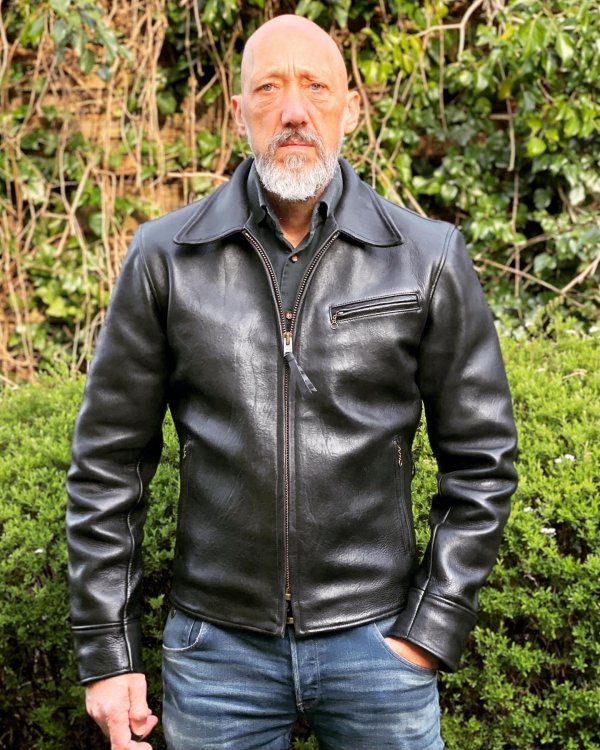 35CFDE0C-049C-4BE9-8156-4FC8E2130728.jpeg581.9 KB · Views: 176
35CFDE0C-049C-4BE9-8156-4FC8E2130728.jpeg581.9 KB · Views: 176 -
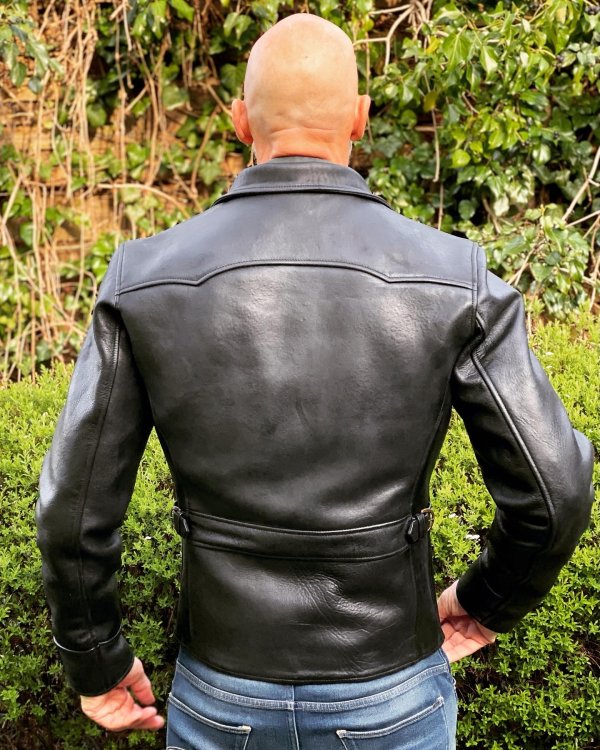 162CB610-D7C8-4D94-B82E-6268C8257432.jpeg683.2 KB · Views: 147
162CB610-D7C8-4D94-B82E-6268C8257432.jpeg683.2 KB · Views: 147 -
 8AC20BF9-1E91-42AD-AA0D-48025EFA9C51.jpeg529 KB · Views: 141
8AC20BF9-1E91-42AD-AA0D-48025EFA9C51.jpeg529 KB · Views: 141 -
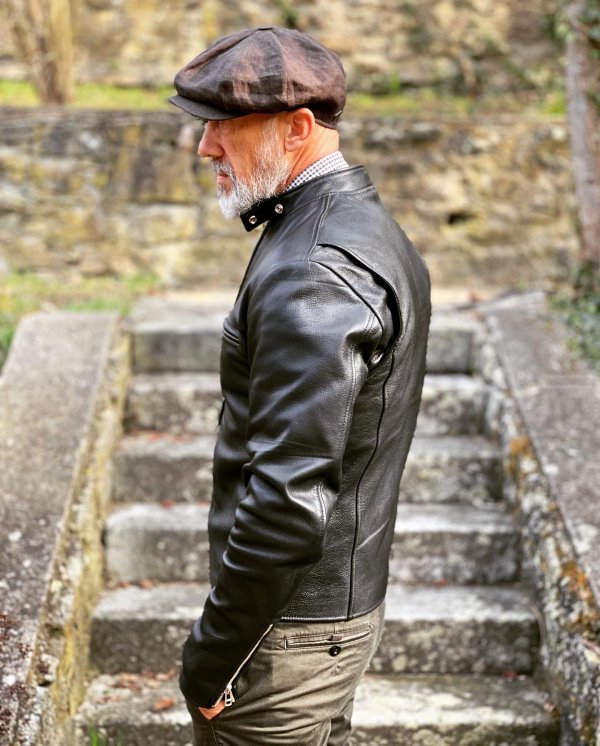 8D43392E-97E0-4ED1-9836-C7168796A8C6.jpeg433.5 KB · Views: 140
8D43392E-97E0-4ED1-9836-C7168796A8C6.jpeg433.5 KB · Views: 140 -
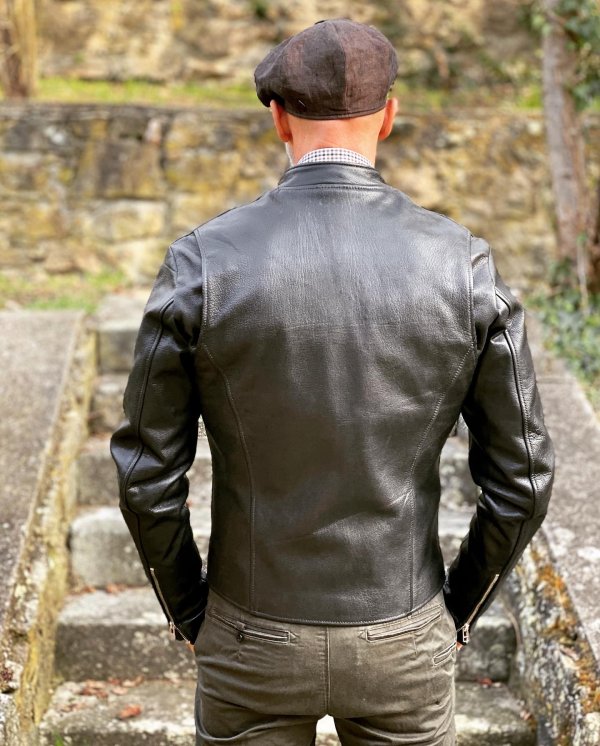 03E3CAB9-FEF8-4B0C-B6B8-6DD499D44764.jpeg504.6 KB · Views: 132
03E3CAB9-FEF8-4B0C-B6B8-6DD499D44764.jpeg504.6 KB · Views: 132
spectre6000
One of the Regulars
- Messages
- 192
I've got leather samples coming. $30 bailout point.
It's a project. Learning is possibly the primary goal.
It's a project. Learning is possibly the primary goal.
Canuck Panda
I'll Lock Up
- Messages
- 5,017
Darts are used to bring in the curve or to create a curve right? Wouldn't French seams panels accomplish the same or similar? Or like this cossack where there is curved inside facing panel to give an curve look once the leather has settled, or imprinted (on purpose) onto the other side so to speak.

I really think going deep and starting from scratch pattern deserves its own thread for discussion... It could parallel at certain points with this 5* thread but it (pattern from scratch) really deserves its own dedicated thread.
I really think going deep and starting from scratch pattern deserves its own thread for discussion... It could parallel at certain points with this 5* thread but it (pattern from scratch) really deserves its own dedicated thread.
Featured products
-
 John Lofgren Monkey Boots Shinki Horsebuttt - $1,136 The classic monkey boot silhouette in an incredibly rich Shinki russet horse leather.
John Lofgren Monkey Boots Shinki Horsebuttt - $1,136 The classic monkey boot silhouette in an incredibly rich Shinki russet horse leather. -
 Grant Stone Diesel Boot Dark Olive Chromexcel - $395 Goodyear welted, Horween Chromexcel, classic good looks.
Grant Stone Diesel Boot Dark Olive Chromexcel - $395 Goodyear welted, Horween Chromexcel, classic good looks. -
 Schott 568 Vandals Jacket - $1,250 The classic Perfecto motorcycle jacket, in a very special limited-edition Schott double rider style.
Schott 568 Vandals Jacket - $1,250 The classic Perfecto motorcycle jacket, in a very special limited-edition Schott double rider style.
- Messages
- 17,683
I think if you temper your expectations, you’ll be just fine. You’ve got a lot going on here and you’ve invested quite a bit of time and effort. So long as you accept the outcome for what it is, I think you’ll be alright. One thing to remember, and I’m sure you’ve read as much, 5 Star will deliver what you present them. For better or (frankly often) worse. If you leave any room to interpret….I've got leather samples coming. $30 bailout point.
It's a project. Learning is possibly the primary goal.
It’s like this:
spectre6000
One of the Regulars
- Messages
- 192
Initially I didn't think so, but I'm actually starting to agree with you here. I wasn't planning to do an actual pattern, but now I'm sort of getting a feel for it... Sort of seeing how it works. I really was just trying to figure out where and how to place the darts and how they work so that it wasn't just "art", but now that I've got that paper shell fitting like skin, it's sort of down hill from here.... I'm still sort of figuring this out though, and I hate it when people post those things where they make themselves out to be experts, but are just figuring it out as they go. Maybe I can just couch it like that... Stay tuned. I'm playing this by ear, and it's pretty much a new domain for me...Darts are used to bring in the curve or to create a curve right? Wouldn't French seams panels accomplish the same or similar? Or like this cossack where there is curved inside facing panel to give an curve look once the leather has settled, or imprinted (on purpose) onto the other side so to speak.
View attachment 592525
I really think going deep and starting from scratch pattern deserves its own thread for discussion... It could parallel at certain points with this 5* thread but it (pattern from scratch) really deserves its own dedicated thread.
I think you just picked up what I'm putting down.I think if you temper your expectations, you’ll be just fine. You’ve got a lot going on here and you’ve invested quite a bit of time and effort. So long as you accept the outcome for what it is, I think you’ll be alright. One thing to remember, and I’m sure you’ve read as much, 5 Star will deliver what you present them. For better or (frankly often) worse. If you leave any room to interpret….
A) I don't have experience or standards like a lot of people here do. For better or worse. Ignorance is a state of not knowing, and it's how we all start out. If you're sitting on a collection of incredible jackets, and that is just the tip of your experiential ice berg, then Fivestar is probably pretty disappointing. If, however, you're in my shoes, and once owned an ill fitting mall jacket back in the 90s, full stop. And absolutely no jacket you've ever encountered has ever fit very well... The bar is low. It'll be hard to disappoint. I minored in philosophy back in college, and while my focus was ethics, it's hard to not pick up a few other things. One of which was an appreciation for Stoicism; specifically Seneca. Long story short, and oversimplified to the point that it loses almost all meaning, if you expect the worst, you can only be happy with the result. My expectations have been set very low. Worst case scenario, those expectations are met. I'm doing my best to hedge against this by making a project out of it, getting samples, and getting a prototype jacket made (having a couple of solid and talented sewing enthusiasts close to hand certainly doesn't hurt). Best case scenario, I'm thrilled with a great result. With that as the spectrum, I'll have to try pretty hard to lose.
B) I'm an engineer, and Fivestar seems to me to be acting exactly like a machine. Very GIGO. I've carefully observed the last three years worth of experiences. I've taken note when they work, what worked, and how. And I've taken note of when they fail in the same way. I think I have an idea for what's happening on the ground there*, and I'm putting in the leg work to make sure I understand the programming. This pattern making exercise is part of that effort. As a bonus, it's fun, and I'm learning things. Hopefully stepping into this hobby in my own special idiomatic way, and maybe, if I'm lucky, sparking some new insights for others (sounds like that's happening at least to some degree between the microscopy and this pattern making exercise). I'm learning to read the code Fivestar executes, and I think also learning to write it. It'll be a slow burn.
*I think they take their pattern makers from the white label side and have them modify existing patterns to try to emulate what is asked of them. These pattern makers are not fashion school graduates or anything like that. They're factory workers. They do their best, and if I were in the same position, I'm sure I'd be doing it exactly the same way. But, they're taking mall patterns, which are not held to the same standards as a lot of what floats around here, and project onto them. If you poke around on Amazon and wherever else you find this level of jacket, you see where they're coming from. It's a step up, but not without its systemic limitations. If you WANT three dimensional sleeves, you have to point to a pattern they have where this has been done, provide something to replicate (has been done, see the link), or make and communicate the pattern (unnecessary unless you want something more or different than what's available from the previous two options). The torso is more of a challenge, for me at least, because I don't really care for the jackets they've reproduced, and I don't have anything to reproduce. So I have to make and communicate enough of a pattern to get past the two dimensional problem. I'm still figuring this out, but I guess I'm about to start sharing that process...
I think you’re going about this with the right mindset, as it looks like for you the process is more interesting than the result.... The bar is low. It'll be hard to disappoint. I minored in philosophy back in college, and while my focus was ethics, it's hard to not pick up a few other things. One of which was an appreciation for Stoicism; specifically Seneca. Long story short, and oversimplified to the point that it loses almost all meaning, if you expect the worst, you can only be happy with the result. My expectations have been set very low. Worst case scenario, those expectations are met. I'm doing my best to hedge against this by making a project out of it, getting samples, and getting a prototype jacket made (having a couple of solid and talented sewing enthusiasts close to hand certainly doesn't hurt). Best case scenario, I'm thrilled with a great result. With that as the spectrum, I'll have to try pretty hard to lose.
As you mentioned Seneca and in an attempt to modify (reverse or butcher) his classic aphorism: “If one does not know to which port to sail, any wind is favorable”, in your case would be: “if you’re not concerned with which port to arrive, any wind is favorable”.
spectre6000
One of the Regulars
- Messages
- 192
Haha! I was mostly thinking in terms of stoic pessimism and his thoughts on the origins of anger. The particular allegory that comes to mind is when Nero threw the slave to the lampreys for dropping/breaking the crystal goblet. He expected it to be perfect forever, rather than accepting that not only is it in the nature of crystal to break, but that fragility is exactly what makes it precious. If you acknowledge/expect that it WILL inevitably break (the jacket won't be perfect), you won't be surprised/angered when it does. Each time it DOESN'T break (the jacket turns out great) will thereby be a pleasant surprise.
Now pass all that through the lens that it's been nearly 20 years since I read that particular book, and some wires could have crossed in that time.
Now pass all that through the lens that it's been nearly 20 years since I read that particular book, and some wires could have crossed in that time.
Well in that case, I hope your goblet doesn’t break, and it turns out precious.
Good news is that leather is more resilient than crystal, so you have that to your advantage…
Good news is that leather is more resilient than crystal, so you have that to your advantage…
Haha! I was mostly thinking in terms of stoic pessimism and his thoughts on the origins of anger. The particular allegory that comes to mind is when Nero threw the slave to the lampreys for dropping/breaking the crystal goblet. He expected it to be perfect forever, rather than accepting that not only is it in the nature of crystal to break, but that fragility is exactly what makes it precious. If you acknowledge/expect that it WILL inevitably break (the jacket won't be perfect), you won't be surprised/angered when it does. Each time it DOESN'T break (the jacket turns out great) will thereby be a pleasant surprise.
Now pass all that through the lens that it's been nearly 20 years since I read that particular book, and some wires could have crossed in that time.
spectre6000
One of the Regulars
- Messages
- 192
It's all good. Try it out and you'll know. I just wanted to point out that the darts are just one option and I would consider the others as well, as long as I'm not planning to design a Roman breastplateI've got leather samples coming. $30 bailout point.
It's a project. Learning is possibly the primary goal.
I received photos yesterday on an order placed on the 10th. So 10 days, semi-custom A-1 with front zipper instead of buttons, standard sizing. . Proper credit to a fellow member for the original idea, way back in the thread. Nudge-nudge.Anyone know the current wait time from order to QC photos?
Just had to try out that much-liked 1.2mm seal goatskin before (hopefully) calling the whole adventure good.. And for me and my simple requirements and limited budget, it was all good!
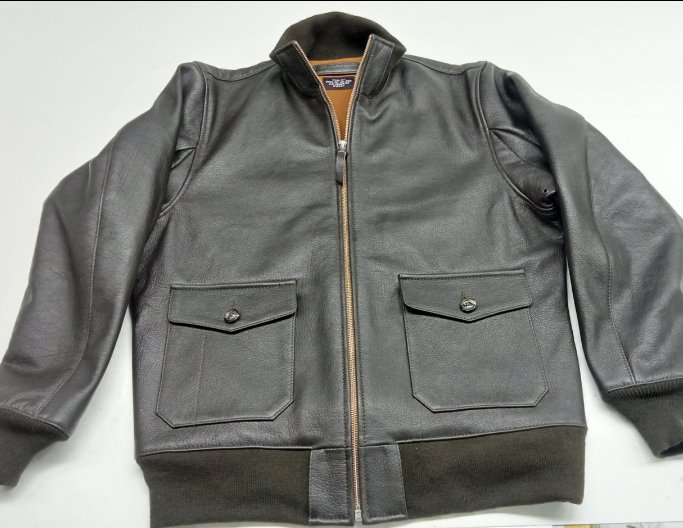
This was my first jacket from 5*I received photos yesterday on an order placed on the 10th. So 10 days, semi-custom A-1 with front zipper instead of buttons, standard sizing. . Proper credit to a fellow member for the original idea, way back in the thread. Nudge-nudge.
Just had to try out that much-liked 1.2mm seal goatskin before (hopefully) calling the whole adventure good.. And for me and my simple requirements and limited budget, it was all good! View attachment 592626
The pattern was based on a picture of Amelia Earhart's jacket.
This was also the first time that the jacket was folded in such a way that the desired measurements were visible on the measuring tape. It then had to be reworked to achieve the desired dimensions.
Attachments
Yet no sign of my LAPD custom size ordered on the 9th—maybe I didn’t tip enough…I received photos yesterday on an order placed on the 10th. So 10 days, semi-custom A-1 with front zipper instead of buttons, standard sizing. . Proper credit to a fellow member for the original idea, way back in the thread. Nudge-nudge.
Just had to try out that much-liked 1.2mm seal goatskin before (hopefully) calling the whole adventure good.. And for me and my simple requirements and limited budget, it was all good! View attachment 592626
Similar threads
- Replies
- 48
- Views
- 16K
- Replies
- 51
- Views
- 17K
Members online
- Tiki Tom
- hardlyworkingman
- JackBroChill
- Shawnziee
- Kaiden
- zacharge
- Fallentaxi
- Grayland
- Rmccamey
- Setenta
- CaserJonez
- JonS1967
- Mickiemac
- BarryMcCockiner_PhD
- JB1
- Sirkrimzon
- mtrlr
- tweedydon
- X83
- danogun
- 111Joel111
- AerGuitar
- Seank
- mdgnowles
- Thearikmor
- Buick
- Lipmann01
- RossRYoung
- Ent
- sal
- lucyismylady
- Torvic
- Will Zach
- harubaji
- Jfk1117
- Ai-Phu-Gyu
- Mothkok
- Retserrof
- rickc007
- jchance
- iterswap
- Aladeen's magic carpet
- Mister Rivets
- quikrick
- Ragazzi West Loop
- joezam713
- DavidT
- teacore_bug
- Leather Canary
- stmike
Total: 4,513 (members: 73, guests: 4,440)

